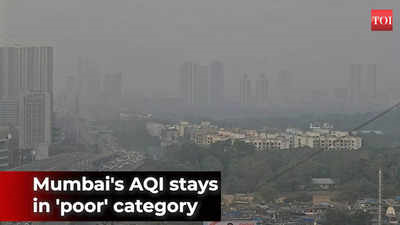Breathless in Mumbai
Climate change has negated its pollution-cleansing advantage. City needs plans for long-term control
Relevance
- GS Paper 3 Conservation, environmental pollution and degradation, environmental impact assessment.
- Tags: #climatechange #airpollution #globalwarming #india #currentaffairs #upsc
Why in the News?
Mumbai has experienced an air quality crisis during the post-monsoon period for the second consecutive year.
The Pollution Predicament
- Among Indian metros, Delhi often takes the spotlight for its notorious pollution levels, but it’s increasingly clear that air quality issues are widespread.
- As highlighted in a recent series in this newspaper, Mumbai has been grappling with an air quality crisis during the post-monsoon season for the second consecutive year.
- Throughout most of October, the Air Quality Index (AQI) in Maharashtra’s capital has consistently fallen in the “moderate” to “poor” range, with not a single “good” air day this month.
Visible Pollution
- The actual pollution levels often exceed AQI readings, as witnessed in the initial days of October when a haze veiled the Mumbai skyline, causing reduced visibility.
- Although this haze consists of coarser particles that cause irritation but are less harmful than finer PM2.5 particles, it underscores the pollution challenge.
- Meteorological conditions play a role in pollution, but it’s essential to remember that the weather and climate don’t create pollution; instead, it exacerbates existing issues caused by anthropogenic emissions.
Mumbai’s Unique Advantage
- Mumbai’s coastal location offers a natural cleansing mechanism for pollutants. Strong surface winds facilitate the rapid dispersal of pollutants, and the sea breeze helps clear these particles from the land.
- This advantageous wind pattern is characteristic of the city for most of the year, ensuring better air quality.
The Impact of Climate Change
- However, the post-monsoon season in recent years has raised concerns due to unfavorable meteorological conditions.
- Delays in the monsoon’s withdrawal complicate matters. To understand this anomaly, it’s crucial to recognize that the “usual” conditions are changing due to additional anthropogenic factors, such as last winter’s record-breaking particulate pollution, linked to unusual La Niña conditions.
Festival Season Challenges
- With the festival season approaching in mid-November, concerns about increased emissions arise. Although festivities may temporarily worsen air quality, the focus should shift to long-term mitigation plans.
- Climate change is causing extreme weather events and ecosystem changes, especially in vulnerable coastal regions like Mumbai. The root cause of the problem remains anthropogenic emissions, and addressing this is vital.
Long-Term Mitigation Strategies
- Tackling air pollution is a complex, long-term battle. Initiatives such as green curtains around construction sites, regular dust particle dampening, transitioning to fossil fuel-less transportation, and managing traffic flow can help mitigate pollution in the short term.
- However, medium-term efforts should include transitioning to electric vehicles, improving solid waste management, addressing dumping grounds, and managing industrial toxins. Climate change necessitates swift action, and we must rely on data from reliable scientific sources to drive informed decisions and changes.
In the fight against air pollution, understanding the issue and acknowledging it are crucial steps toward a solution. Mumbai must prioritize long-term strategies that focus on addressing airshed areas where pollutants get trapped. By taking steps to reduce anthropogenic emissions and embracing sustainable practices, Mumbai can combat its air quality challenges and contribute to a healthier and cleaner future.
|
Steps taken by the government to combat Air Pollution The National Air Quality Index (AQI)
Graded Response Action Plan (GRAP)
The measures under GRAP are categorized according to pollution levels, with specific actions for each category:
SAFAR (System of Air Quality and Weather Forecasting And Research)
|
Sources: Indian Express
Mains Question
Discuss the air quality challenges faced by Mumbai and the impact of climate change on its pollution levels. How can Mumbai address these issues effectively while considering the unique coastal and geographical aspects of the city?




